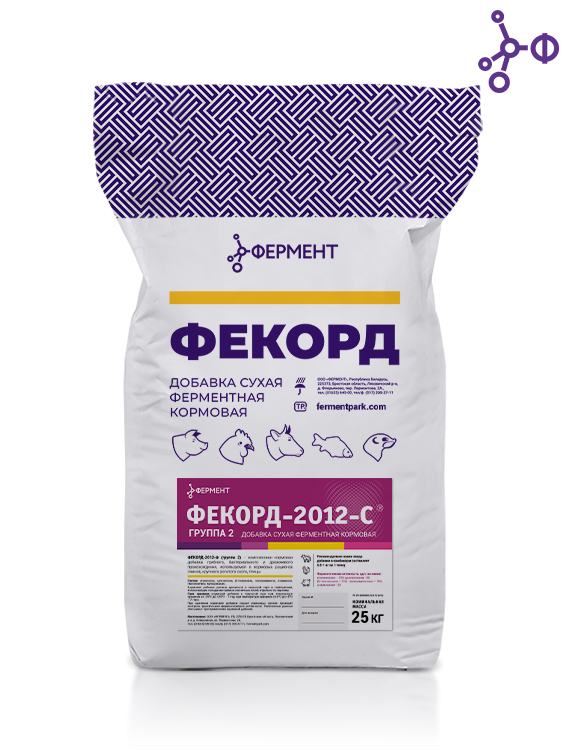- Ferment ООО
Dry enzyme feed additive:
-
"Fekord-2012-S (group 1)";
-
Fekord-2012-S (group 2)".
Composition
enzymes: cellulase, xylanase, glucoamylase, α-amylase, β-glucanase and protease (producer strains Trichoderma reese, Aspergillus niger, Aspergillus oryzae, Bacillus amydoliguefaciens, Bacillus subtilis, Pichia Pastoris), filler (wheat or rye flour, wheat or rye bran, maltodextrin, zeolite, dietary salt, feed chalk).
Purpose
It is used in the feed rations of farm animals and poultry to improve the nutrient value by destruction of hydrocarbons that are difficult to hydrolyze.
Biological properties
Dry enzyme feed additives "Fekord-2012-С (group 1)" and "Fekord-2012-С (group 2)" facilitate:
-
destruction of anti-nutritional non-starch polysaccharides;
-
destruction of grain endosperm cell walls and increase of cellular starch and protein availability for endogenous enzymes in poultry and animals;
-
increase of digestibility of raw protein, carbohydrates and lipids of the feed;
-
decrease of feed viscosity, improvement of nutrients digestibility and their absorption in the small intestine;
-
decrease of specific feed consumption per unit of the manufactured products;
-
increase of livestock and poultry productivity.
Presentation
Cream white to light brown homogeneous powder.
How to use
For agricultural birds, pigs and bovine cattle of any age and sex groups, feed additives are recommended for inclusion in diets containing up to: 65% of wheat, 30% of rye, 70% of barley, 50% of oatmeal, 20% of wheat middling, 20% of sunflower oil meal, 60% of triticale, 75% of corn and other forage products with the increased content of non-starch polysaccharides (NPS) and phytine compounds.
Recommended rate of enzyme feed additives adding to the compound feed for pigs, cattle and poultry:
-
"Fekord-2012-S" (group 1) - 50 - 100 g per 1 ton of feed;
-
"Fekord-2012-S" (group 2) - from 500 to 1000 g per 1 ton of feed.
The additives are introduced at the plants producing premixtures, AVMA and compound feed or at the feed shops, by using current mixing technologies.
Stability
Feed additives remain effective at pH value from 2.0 to 9.0. They shall withstand temperature up to 95°С during granulation.
Advantages of using
-
hydrolytic cleavage of arabinoxylans and β-glucans, cellulose and other anti-nutritional non-amyloid polysaccharides contained in feed;
-
destruction of plant cell walls by exogenous enzymes, which increases the availability of contained starch, proteins, and lipids for enzyme induction in the gastrointestinal tract;
-
increased availability of proteins, amyno acids, carbohydrates, iron, magnesium, calcium and other minerals;
-
significant increase in the digestion of calcium, protein, and energy;
-
phosphorus release from the phytate cereal complex by means of the phytase action;
-
increase in the ration feeding value by means of more complete extraction of nutritional substances and energy release;
-
improved microflora in the small intestine by means of viscosity reduction of contents in the intestine and the increase in the monosaccharide level; improved sanitary and hygienic conditions of production rooms;
-
digestive enzyme deficit compensation in early stages of young livestock animal and poultry growth when the production of native enzymes is limited, and during the stress;
-
increase in livestock survival;
-
reduction of specific feed consumption per unit of the products produced;
-
5-8-fold reduced necessity of the application of phosphorus additives without deteriorating the quality of mixed feed;
-
significantly reduced feed costs;
-
increased gain of weight of animals and poultry and increased poultry egg-laying capacity;
- increased productivity of farm animals and poultry.
Efficiency
The application of FEKORD-2012-S provides the increase in the broiler body weight by 5.4-9.2 %, improves the feed conversion ratio by 5.8-12.2 %, increases the intensity of egg-laying capacity of hens by 2.5-6.5 %, and reduces the feed consumption per unit of production by 5.1-8.6 %.
Use of feed supplement FEKORD-2012-C when feeding swine, increases the feed energetic value, herewith actual nutrition value grows by 5-10%; average daily gain is increased by 4.6-5.4%, survival of the young and adult stock is increased by 2.8-5.6%, production cost decreases by 5.4-8.8%; infectious diseases level is decreased by 3.5-4.9%.
Use of feed supplement Fekord-2012-S when feeding young cattle stock helps increase particle transmission in the tripe, accessibility of cellulose and nitrogen in the tripe, digestibility of the dry and organic matter, protein, fat and cellulose by 6.0-13.1%; feed conversion by 9.5-11.0%; milk yields by 5.3-9.6% and fat content in milk.



